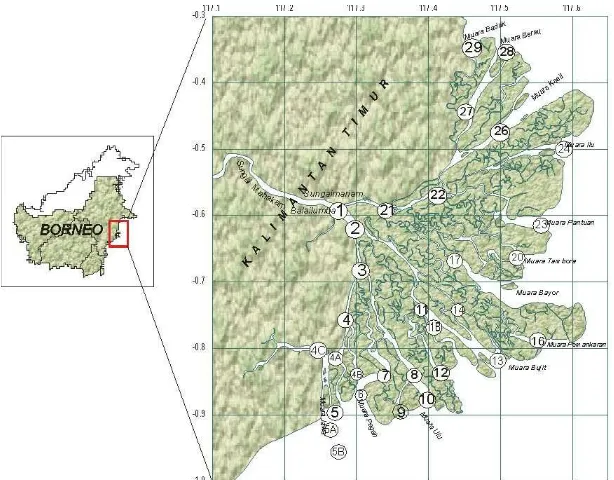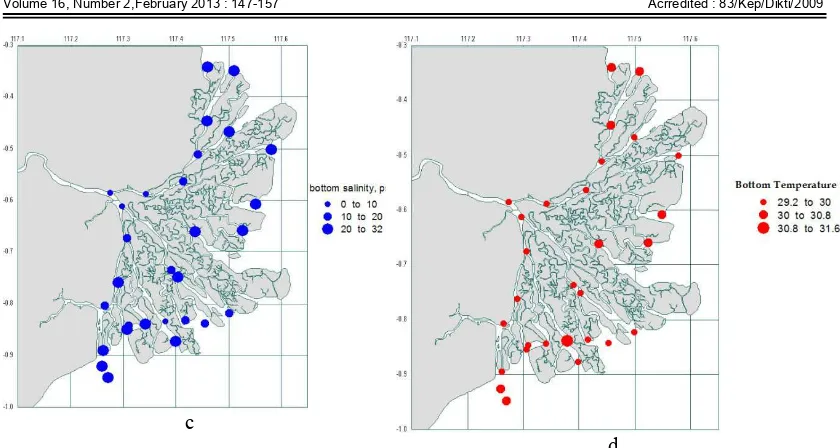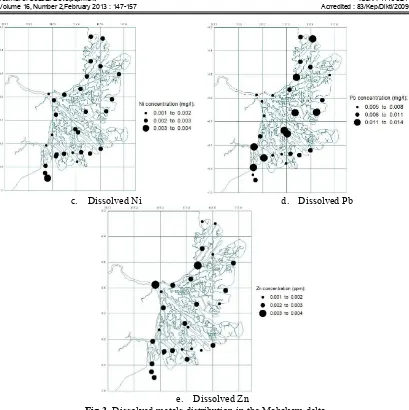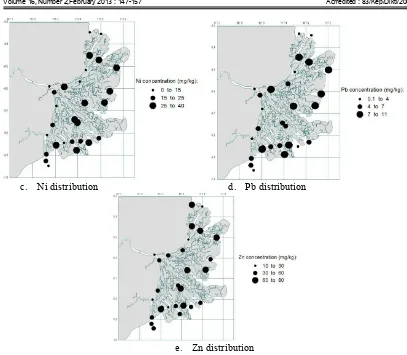Journal of Coastal Develpopment ISSN : 1410-5217
Volume 16, Number 2,February 2013 : 147-157 Acrredited : 83/Kep/Dikti/2009
147 Original Paper
STUDY OF METAL CONTAMINANT LEVEL IN THE MAHAKAM
DELTA: SEDIMENT AND DISSOLVED METAL PERSPECTIVES
Fitri Budiyanto*and Lestari
Research Center for Oceanography, Indonesian Institute of Sciences Jl. Pasir Putih 1 No. 1, Ancol Timur, Jakarta 14430, Indonesia
Received: January, 2, 2013; Accepted February, 27, 2013
ABSTRACT
The Mahakam Delta in East Kalimantan contains large number of natural resources specially hydrocarbon sources. Anthropogenic activities have influenced this ecosystem for many years. The aims of this work were to find out dissolved metal and metals in sediment distribution in this area and to find out contaminant level based on allowable guidelines. Twenty nine stations were sampled within the delta and metal content analyses, both in sediment and water column, were established for Cd, Cu, Ni, Pb and Zn. Sediment analyses were conducted using US EPA 3050B method and dissolved metals analyses were conducted using Back Extraction method. Cd, Cu, Ni, Pb and Zn in sediment had 0.07 mg/kg dw, 18.64 mg/kg dw, 35.62 mg/kg dw, 10.56 mg/kg dw and 74.95 mg/kg dw in maximum concentration respectively. Whereas dissolved Cd, Cu, Ni, Pb and Zn had 0.001 mg/l; 0.003 mg/l; 0.003 mg/l; 0.013 mg/l and 0.003 mg/l in maximum concentration respectively. Based on allowable guidelines, metals contaminat levels, both in sediment and water column, were below permitted value.
Keywords: Mahakam delta, Metals, sediment and water column
Correspondence: Phone: +6221-64713850 ext. 313 Fax. +62-21-64711948-; E-mail: [email protected]
I
NTRODUCTIONEstuarine systems are among the most productive and dynamic ecosystems on earth. Coastal and estuarine watersheds currently support 75% of the world’s population and are still rapidly being developed (Corbett et al., 2009). Water and sediment quality which is vital for the survival and well being of the living resources, especially in the coastal and estuarine areas, is governed by many factor including heavy metals. Knowledge of distribution and concentrations of heavy metals in the sediments will help detect the source of pollution in the aquatic systems (Nobi et al., 2010). The concentration of metals found in sediments is the result of natural phenomena, anthropogenic activities or the combination of both (Munoz-Barbosa et al., 2012; Varol, 2011). In addition, sediments play a major role in the overall fluxes of trace elements in coastal systems, acting occasionally as a source and/or sink (Guo et al., 2010; Sakellari et al., 2011). Many researcher believed that the sediments
were indicator for water pollution and the distribution of heavy metals in the sediments could reflect the water pollution level (Guo et al., 2010).
Sea water contains low concentration of most metals in solution and can be modified regionally through volcanic activity, metheorization and/or erotion of the detritus phases of the rocky basement and fluvial contribution. Although rivers transport small amounts of dissolved metals, these can alter the natural proportion of local sea water by dilution or enrichment of some major and minor cations (Ahumada et al., 2011).
148 and fauna and may enter in the human food chain and result in health problems (Apeti et al., 2009; Ciutat et al., 2009; Mei et al., 2011; Varol, 2011).
Mahakam delta were formed by the sedimentation processes of the Mahakam River, the longest river in east Kalimanatan, for thousands of years. Vast plain is approximately 1700 km2 in wide, devided in four zones of vegetation: forest tree of low land tropical forest, palm tree and mixed lowland forest, mangrove swamps and palm. The last two vegetation zones, because of its spread depends on the presence of sea water, often referred to jointly as mangrove forest and cover 60% of the delta plain (Husain, 2006).
Mahakam delta is one of Indonesia richest region for natural resources, specially in hydocarbon content (Ilahude, 2003). Since more than 30 years ago, oil and gas companies have focused to operate in this region and have brough periods of prosperity. In the other side, local residents face a damaged environment (Anonimous, 2011). Declining quality of drinking water, shrimp livestock disease, increased coastal erosion and rivers, horizontal conflicts caused and potential fisheries in
mangrove forests declined drastically (Husain, 2006).
The purpose of the study were determining Cd, Cu, Ni, Pb and Zn distribution in water colomn and bottom sediment contents of Mahakam delta and its contaminant level due to allowable guideline.
M
ATERIALS ANDM
ETHODSSampling Site
Sediment samples were collected at 29 stations in Mahakam Delta along geographycal area of 117015’-117035’ E dan 0020’-0057’ S (Fig. 1), located using the Global positioning System (Garmin GPS). In each station, sediment sample was taken with a Ponar Grap and homogenous mixing of surface sediment (0-10 cm) was formed. Sediment samples were transported to the laboratorium under cooling condition (Hutagalung et al., 1997; Lestari and Witasari, 2010). Water samples were taken with water sampler van dorn at 0.5 m in depth and were filtered using 0.45 µm Whatmann filter paper then preserved using 1mL HNO3 / 1L sample.
Journal of Coastal Develpopment ISSN : 1410-5217
Volume 16, Number 2,February 2013 : 121-134 Acrredited : 83/Kep/Dikti/2009
149 Analitical Procedure
All Analyses were conducted in heavy metal laboratory, Research Center for Oceanography LIPI according to USEPA 3050B methods. Collected sediment was heated at 1050C then a gram of dry sediment was weighed and destructed using three kind of acids. The addition of nitric acid (1+1), concentrated nitric acid, H2O2 and concentrated hydrochloric acid were simultanously established to destruct sediment sample. Sample solution was heated in hotplate in vary heating time. Destructed sample was filtered with whatman No. 41 and was diluted to 100 mL aquadest. On the other hand, water samples were analyses using Back Extraction Method (Standard Method, 1992). 250 mL sea water (pH 3-3,5) were extracted using 2.5 mL of 4% Ammonium pyrrolidine dithiocarbamate and 25 mL sodium diethyl dithiocarbamate/ methyl isobuthyl ketone. Collected extract was rinse by aquadest and destructed using 0.25 mL concentrated HNO3. Both sediment and sea water sample solutions were analyzed using Atomic Absorption Spectrophotometer Varian SpectAA 20.
Data Analysis
Pearson’s correlation was used to understand the association of metals with physical
parameters. On the other hand, the contaminant level of Cd, Cu, Pb, Ni and Zn were assessed by comparing with quality guideline, Indonesian and Australian water quality guideline for dissolved metals and Canadian sediment quality guideline for metals in sediment.
R
ESULTS ANDD
ISCUSSIONResults
Salinity and temperature showed tropical estuarine characteristics (Figure 2). Salinity and temperature measurement was taken in surface and bottom water column. Minimal salinity in the surface water was 0.03 psu at upper river and increasing towards the estuary, 29.21 psu as the maximum value, 15.71 psu in average. There were no significant suface water temperature differences between stations, in the range of 29.300C-31.50C (Figure 2a and b). Bottom waters had higher temperature and higher salinity than surface waters. Water column had 29.86 0C in average bottom temperature and 19.22 psu in average bottom salinity.
150 c
d
Fig. 2. Distribution of surface water salinity (a), surface water temperature (b), bottom salinity (c) and bottom temperature (d)
Heavy metal in water analyses were conducted for Cd, Cu, Pb, Ni and Zn. The obtained data represented Cd less than 0.001 mg/L in entire stations except for station 2, 0.001 mg/L (Fig. 3a). Cd spread evenly in the delta areas however Cu and Ni seem to be distributed in the south of the Delta. River stream to Muara Jawa showed relatively high concentartion of
both Cu and Ni, 0.003 mg/L in maximum concentration and 0.002 mg/L in average concentration (Fig. 3b and 3c). Pb detected 0.013 mg/L in maximum concentration and 0.009 mg/L in average concentration (Fig 3d). Whereas, maximum Zn concentration, 0.003 mg/L, identified in the North stream (Fig 3.e)
Journal of Coastal Develpopment ISSN : 1410-5217
Volume 16, Number 2,February 2013 : 147-157 Acrredited : 83/Kep/Dikti/2009
151
c. Dissolved Ni d. Dissolved Pb
e. Dissolved Zn
Fig 3. Dissolved metals distribution in the Mahakam delta
Cd, Cu, Ni, Pb and Zn were analyzed in sediment of The Mahakam Delta. Those metals distributed at the river mouth in preference. Cd, Cu, Ni, Pb and Zn have 0.07 mg/kg dw, 18.64
mg/kg dw, 35.62 mg/kg dw, 10.56 mg/kg dw and 74.95 mg/kg dw in maximum concentration respectively (Fig 4).
152
c. Ni distribution d. Pb distribution
e. Zn distribution
Fig 4. Heavy Metals distribution in sediment
Pearson correlation was conducted to identify salinity effect on dissolved metals pattern and the result, no significant correlation was detected (Table 1). Dissolved Cd, Cu and Zn
indicated negative correlation with dissolved Pb, Ni, Temperature and salinity.
Table 1. Pearson Correlation for temperature,
salinity and dissolved metals.
temperature salinity Pb Cd Cu Zn Ni
temperature 0.374 0.081 -0.246 -0.097 -0.190 0.156
salinity 0.331 -0.329 -0.116 -0.153 0.367
Pb -0.268 0.145 -0.055 0.150
Cd -0.029 -0.220 0.060
Cu 0.468 0.226
Zn -0.032
Comparing with another estuary, Mahakam delta was quite similar with Port Jackson, Australia (Table 2). However, this
Journal of Coastal Develpopment ISSN : 1410-5217
Volume 16, Number 2,February 2013 : 147-157 Acrredited : 83/Kep/Dikti/2009
153
Table 2. Dissolved Metals concentration (µg/l) from Mahakam delta and other coastal zones
Element Location
Mahakam Delta Open Coastal Pasific Ocean Port Jackson, Australia
Cd <1 - 1 0.01 0.006 - 0.104
Cu 1 - 3 0.09 0.932-2.55
Ni 1 - 3 0.2 0.175-1.61
Zn 1 - 3 0.2 3.27-9.66
Reference This Study (Batley, 1996
in Hatje et al., 2003)
Hatje et al., 2003
Table 3. General acceptable levels of dissolved metals for marine environment (µg/l)
Country
Treshhold (µg/l)
Refference
Cd Cu Ni Pb Zn
Indonesia:
1 8 50 8 50 Indonesian Ecological
Ministry, 2004 Australia and
New Zealand <0.5 – 5 < 100 <1-7.0 ANZECC, 2000
ASEAN
10 8.5 AMEQC, 1999
Metals in sediment showed non conservatives behaviour and showed no significant correlation with temperature (Table 4). However, metals in sediment indicated varying
correlation each others. Pb showed strong correlation with Cu, Zn and Ni.
Table 4. Pearson Correlation for Temperature, Salinity and Metals in sediment.
Temperature Salinity Pb Cd Cu Zn Ni
Temperature 0.096 0.010 -0.156 0.110 0.245 0.223
Salinity 0.268 0.229 0.267 0.458 0.276
Pb 0.329 0.851 0.682 0.779
Cd 0.503 0.393 0.469
Cu 0.861 0.951
Zn 0.900
Maximum metals concentrations were below permitted guideline. However, maximum Cu
concentration almost reached ISQG allowable value (Table 5).
Table 5. Comparison of guideline metal in sediment and maximum concentration in this study (mg/kg dry weigh)
Treshold element
Cd Cu Ni Pb Zn
Max conc
in this study 0.07 18.64 35.62 10.56 74.95
CCME, 1999 ISQG 0.7 18.7 30.2 124.0
PEL 4.2 108.0 112.0 271.0
Discussion
Trace metals availability, spatial distribution and behaviour are highly regulated by hydrodynamics, biogeochemical processes and
154 environmental condition but dissolved organic carbon and composition of the suspended particulate matter also (Hatje et al., 2003). Chemical characteristic can vary over time and by location and can be impacted by increasing anthropogenic input (DePalma et al., 2011). In estuaries, the mixing of freshwater high in trace metal concentrations with low concentration marine water may have a dilution effect on metal concentartions (Apeti et al., 2009).
Mahakam delta showed non
conservatives behaviour of dissolved metals. Dissolved Cd represented the equitable distribution. dissolved Cu, Ni and Pb tend to accumulate in the mouth of river. Dissolved Zn distributed in the north. There were no significant correlation showed between dissolved metals. This result supported Beck et al., (2010) report which indicated geochemical cycles occuring at the interface between terrestrial and marine groundwaters, called subterranean estuary, are not well understood for most elements. The widespread of anthropogenic sources of metals in the estuary may explain non conservatives behaviour of dissolved metals. Hence, there is no universal pattern of trace metal behaviour in estuaries (Hatje et al., 2003).
Dissolved metals distribution in Mahakam delta in this study were higher than open coastal ocean. Average dissolved metal concentrations were roughly up to 10 time higher than open ocean. This mean, terrestrial input played important role of dissolved metal distribution. Station 2 indicated high concentration of dissolved Cd due to adsorption of cadmium in Fe oxide/hydroxide (Eggleton and Thomas, 2004).
Dissolved Pb concentration reached the highest level of all dissolved metals. The useful physical properties of Pb have resulted in multiplicity of uses of the metal (Ratcliffe, 1981). Mahakam delta’s anthropogenic activities lead to high release of this metal. Oil and gas transport activities contributed Cd distribution in water column considering Darmono (1995) explanation that Cd found in crude oil.
Dissolved cadmium reported having correlation with dissolved zinc (Hendry et al., 2008; Lane et al., 2005; Ellwood, 2004). Zinc is used in zinc carbonic anhydrase to achieve optimal growth rate. In Zn limited condition, Cd subtitutes Zn in carbonic anhydrase to maintain growth rate. Dissolved Cd has similar spatial distribution pattern to PO4
in open ocean deep and surface water and this labile nutrient associated with organic mater (Morel and Price, 2003). Morel and Price (2003) concluded that the high Cd/PO43- of the coastal water is a consequence of two factors: the high input from terrestrial and continental shelf sediments and changes in biological fractionation with respect to P during uptake in region of high Fe and Zn.
Dissolved Cu and Ni correlated to aquaculture activities. Its enrichment was contributed by anti-foulant product and feeding. Manufactured feeds can contain zinc, copper, cadmium, iron, manganese, cobalt, nickel, lead, magnesium, selenium and mercury (Lorentzen and Maage, 1999).
Metals in sediment showed non conservatives behaviour and showed no significant correlation to temperature. This probably caused by anthropogenic activities release metals to waters. The spatial pattern of metal distribution in sediment could be describe in term of distance from pollutant point source (Ward et al., 1986). However, in riverine system metals would be adsorbed into particulate matter (organic and inorganic) then precipitated and probably distributed trough river stream. Sediment high concentration metal accumulated in the river mouth as an effect of fluvial transport.
Journal of Coastal Develpopment ISSN : 1410-5217
Volume 16, Number 2,February 2013 : 147-157 Acrredited : 83/Kep/Dikti/2009
155 additive (Lorentzent and Maage, 1999) and sailorship activities influenced Cu input. Mahakam delta had dense of river transportation influenced Cu abundance in aquatic environment.
In aquaculture areas, particulate organic material (uneaten feed, faeces and bio-fouling biomass detached from cage structures) settle on seabed where it was degraded by microbes utilizing a variety of electron acceptors (Dean et al., 2007). Reported Elevated level of zinc and copper have been found in fish farm sediments. This report suggested that the zinc and copper sediment enrichment around fish farms was a result of feed and faeces inputs, and anti-fouland products (Brook and Mahnken, 2003).
Zhuang et al., (1994) explained that changes in sediment chemistry affect in contaminant remobilisation. Natural event, such as tidal movement and strom, and anthropogenic activities influenced, such as dredging, dredge disposal and fishing influenced remobilisation of sediment-associated contaminant (Eggleton and Thomas, 2004; Nascimento et al., 2006).
C
ONCLUSIONSMahakam delta have influenced by anthropogenic activities and metals content in this delta, both dissolved state and precipitated stated, was affected by metal input from terrestrial area. Furthermore, many guidelines from other countries used to assess metals contaminant level in the Mahakam Delta. As the result, Conducted comparison indicated that both metal in sediment and dissolved metal were below quidance limit. To achieve aquatic environment health, anthropogenic activities in Mahakam delta should be controlled.
A
CKNOWLEDGEMENTThis work was lead by the deceased Dedi Setiapermana and we acknowledge team members, Abdul Rozak and M. Taufik Kaysupi, Edy Kusmanto and Sumijo Hadi Riyono to support this project.
R
EFFERENCESAhumada, R., A. Rudolph, E. Gonzalez, G. Fones, G. Ssaldias and R. Ahumada-Rudolph 2011. Dissolved trace metals in the water column of Reloncavi Fjord,
Chile. Lat. Am. J. Aquat. Res. 39: 567-574.
Anonimous 2011. Senipah terminal minyak dan kondensat di delta Mahakam (online). quality. Australian and New Zealand Environment and Conservation Council; Agriculture and Resource Management Council of Australia and New Zealand, p. 200-2001.
Apeti, D.A., G.G. Lauenstein and G.F. Riedel. 2009. Cadmium distribution in coastal sediment and molusk of the US. Mar. Poll. Bull. 58: 1016-1024.
Beck, A.J., J.K. Cochran and S.A. Sañ udo-Wilhelmy. 2010. The distribution and speciation of dissolved trace metals in a shallow subterranean estuary. Mar Chem. 21: 145-156.
Brook, K.M. and C.V.W. Mahnken. 2003. Interactions of Atlantic salmon in the pasific Northwest environment III. Accumulation of zinc and copper. Fish. Res. 62: 295-305.
Canadian Council of Ministers of the Environment. 1999. Canadian Sediment Quality Guidelines for the Protection of Aquatic Life: Merucy. In: Canadian Environmental Quality Guidelines, p. 1-5.
Ciutat, A., M. Gerino and A. Boudou 2009. Remobilization and bioavailability of cadmium from historical contaminated sediments: Influence of bioturbation by tubificids. Ecotoxicol. Environ. Safety.
68: 108-117.
156 North Carolina, USA. Mar. Poll. Bull. 8: 1739-1765.
Darmono 1995. Logam dalam sistem biologi makhluk hidup. UI Press, p. 30-50. Dean, R.J., T.M. Shimmield and K.D. Black. D.G. Dixon and D.S. Smith. 2011. Effect of dissolved organic matter and reduced sulphur on copper bioavailability in coastal marine environments. Ecotoxicol. Environ. Safety.74: 230-237.
Eggleton and Thomas, 2004. A review of factors affecting the release and bioavailability of contaminant during sediment disturbance event. Environ. Int., 30: 973-980.
Ellwood, M.J. 2004. Zinc and cadmium speciation in subantarctic waters east of New Zealand. Mar. Chem., 87: 37-58. Guo, W., X. Liu, Z. Liu and G. Li 2010.
Pollution and potential ecological risk evaluation of heavy metals in the sediments around Dongjiang Harbor, Tianjin. Procedia Environmental Sciences, 2: 729-736.
Hatje, V., S.C. Apte, L.T. Hales and G.F. Birch. 2003. Dissolved trace metal distributions in Port Jackson estuary (Sydney Harbour), Australia. Mar. Poll. Bull., 46: 719-730.
Hendry, K.R., R.E.M. Rickaby, J.C.M. de Hoog, K. Weston and M. Rehkämper. 2008. Cadmium and phosphate in coastal Antarctic seawater: Implication for Southern Ocean nutrient cycling. Mar. Chem., 112: 149-157.
Husain, S. 2006. Memahami proses alamiah degradasi lingkungan Delta Mahakam. Majalah Inovasi (online), Vol.7 (accecced on 10 february 2012).
Hutagalung, H.P., D. Setiapermana and S.H. Riyono 1997. Metode analisis air laut , sedimen dan biota, Buku 2. P3O LIPI, p 59-80.
Ilahude, D. 2003. Pesisir Delta Mahakam dan Delta Berau menuju puncak kehancuran. Pusat Penelitian dan Pengembangan Geologi Kelautan. Kementerian ESDM (online). www.mgi.esdm.go.id. (Accecced on 10 February 2012).
Indonesia Ecological Ministry, 2004. Himpunan peraturan di bidang pengelolaan lingkungan hidup dan penegakkan hukum lingkungan, p 826-831.
Salmo salar L. fed a fish-meal based diet with or without supplementation of zinc, iron, manganese and copper from fish feeding. Aquacult. Nut., 5: 163-171. Luoma, S.N. and P.S. Rainbow. 2008. Metal
contamination in Aquatic Environment: Science and lateral management. Cambridge University Press. UK, p 4-50. Mei, J., Z. Li, L. Sun, H. Gui and X. Wang 2011. Assessment of heavy metals in the Urban River Sediments in Suzhou City, Northern Anhui Province, China.
Procedia Environmental Sciences, 10: 2547-2553.
Morel, F.M.M. and N.M. Price. 2003. The biogeochemical cycles of trace metal in the oceans. Science. 300: 944-947 Munoz-Barbosa, A., E.A. Gutierrez-Galindo,
L.W. Daessle, M.V. Orozco-Borbon and J.A. Segovia-Zavala 2012. Relationship between metal enrichments and a biological adverse effects index in sediments from Todos Santos Bay, northwest coast of Baja California, Mexico. Mar. Poll. Bull., 64: 405-409. Nascimento, S.F., H. Kurzweil, W. Wruss and
N. Fenzl. 2006. Cadmium in the
Amazonian Guajará Estuary:
Distribution and remobilization. Environ. Poll. 40: 29-42.
Journal of Coastal Develpopment ISSN : 1410-5217
Volume 16, Number 2,February 2013 : 147-157 Acrredited : 83/Kep/Dikti/2009
157 Ratcliffe, J.M. 1981. Lead in man and the
environment. Ellis Horwood Ltd., p 3-10.
Sakellari, A., M. Plavsic, S. Karavoltos, M. Dassenakis and M. Scoullos. 2011. Assessment of copper, cadmium and zinc remobilization in Mediterranian marine coastal sediments. Estuar. Coast. Shelf. Sci., 91: 1-12.
Standard methods. 1992. Standard Methods for The Examination of water and Wastewater. American Public Health Association, American Public Works Association Water Environment Federation, USA, p 3-15.
Varol, M. 2011. Assessment of heavy metal contamination in sediments of the Tigris
River (Turkey) using pollution indices and multivariate statistical technologies.
J. Hazard. Mat., 195: 355-364.
Ward, T.J. R.L. Correll and R.B. Anderson. 1986. Distribution of cadmium, lead and zinc amongst the marine sediments, seagrass and fauna and the selection of sentinel accumulators, near a lead smelter in South Australia. Australian Journal of Marine and Freshwater Research, 37: 567-585.




